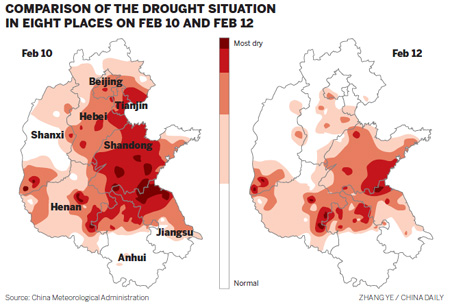 cription="编辑提供的本地文件" sourcename="本地文件" style="width: 450px; height: 305px" />
cription="编辑提供的本地文件" sourcename="本地文件" style="width: 450px; height: 305px" />BEIJING - Recent snowfalls in parts of the country have relieved severe droughts in some of China's major wheat-growing areas, but the situation is still worsening in others, experts and officials have said.
Related readings:
Latest snowfalls insufficient to ease drought
Snowfall in North China helps ease drought
Govt to spend $1b to battle drought
Govt warns of continuous drought in spring
"The droughts in most parts of Central and East China have been relieved to some extent and a good harvest is still promising," Lu Bu, an agricultural resources researcher at the Chinese Academy of Agricultural Sciences, told China Daily on Sunday.
But Shandong, Shanxi, Henan, Anhui and Jiangsu provinces are still experiencing severe droughts, according to the National Meteorological Center (NMC).
Since late Saturday, fresh dumps of snow fell on Beijing and in Hebei, Shanxi, Anhui, Hubei and Jiangxi provinces. Snow is also expected in Gansu, Shaanxi, Shandong, Henan and Jiangsu provinces.
"Although the latest snow has not been heavy, the recent snowfalls will cumulatively play an active role in mitigating the droughts," Lu said.
But the country is still facing the grim task of fighting severe droughts in many areas that could worsen as the weather warms.
Winter wheat is the main worry because it needs large amounts of water when it is turning green, said Chen Lei, deputy director of the Office of State Flood Control and Drought Relief Headquarters. Chen was speaking during a national meeting at the weekend.
As of 3 pm on Thursday, the drought had affected more than 6.75 million hectares of crops, including about 1 million hectares that were described as severely affected. In addition, more than 2.8 million people and nearly 2.6 million farm animals were short of drinking water, according to the latest statistics from the headquarters.
Chen noted that local governments should work to ensure adequate water is available for the spring irrigation of crops and guarantee that people have access to clean drinking water.
The central government has adopted measures to fight the drought and boost grain production, including sending professional teams to guide drought-fighting efforts in affected areas and raising grain purchase prices, he added.
In the coming 10 days, most parts of Central and East China are expected to get precipitation on three occasions but the amount of water involved is likely to be less than 2 mm each time, the NMC said on Sunday.
The center said Shandong and Jiangsu should get between 3 and 6 mm of precipitation, which should ease the thirst of crops there.
During the weekend, Beijing residents were also happy to welcome the city's second snow, three days after the first one this winter had ended the capital's dry spell that extended for 108 days.
The depth of the snow reached 15 cm in some parts of the capital's Haidian district, according to local media reports.
On Sunday morning, the snow grounded 34 flights for more than an hour but things quickly returned to normal, Beijing Capital International Airport announced at noon.
The capital's artificial weather intervention office said precipitation enhancement measures had been taken and silver iodide had been dispersed into the air to encourage more snowfall.
Zhang Qiang, who heads the office, told Xinhua News Agency that 657 loads of silver iodide were burned and dispersed into the atmosphere to encourage more snowfall between 7 pm on Saturday and 10 am on Sunday.
A third dump of snow may fall on Beijing on Tuesday and Wednesday.
Zhang said his office will continue to monitor the conditions and may intervene to encourage more snow to fall in the coming days.
As of early Saturday, Beijing, Tianjin, Hebei, Shandong, Shanxi, Henan, Jiangsu and Anhui had collectively carried out 869 precipitation enhancement procedures to encourage precipitation and alleviate droughts, the NMC said. It added that the situation in most parts of Henan, Shandong, Jiangsu and Anhui remained severe.







